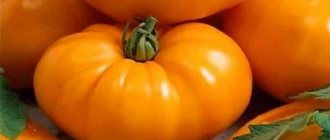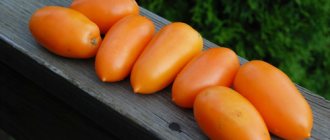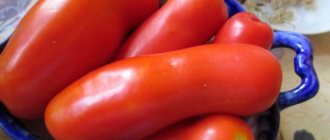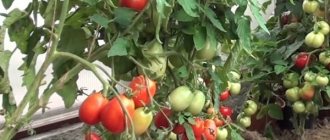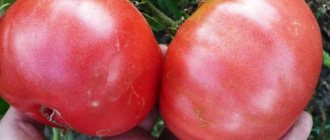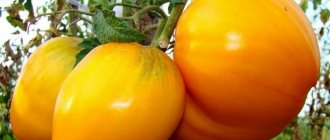Main characteristics
The variety is indeterminate. The bushes are standard, relatively low, in the ground - 70 cm, quite high in the greenhouse - 1.5 m. Characteristics of the speed of fruit ripening - a mid-early plant. Ripe tomatoes should be expected 110 days after the seedlings emerge.
The description of the variety contains recommendations on the choice of soil; to obtain good results it should be:
- light;
- fertile;
- well permeable to air and water.
Fruit
The photo shows the original shape of the tomato – flattened and round. The fruit pulp is bright orange, or yellow in low light. The more sun the bushes receive, the brighter the color of the tomato.
The weight and size of the fruit depend on the method of formation of the bush and the quality of care. On depleted soils, without fertilizing and bush formation, it is unlikely that large fruits will be obtained.
With good agricultural technology for forming a bush with 1 stem and following a planting pattern of 4 roots/m², the fruits can reach a weight of 800 g. In general, the average weight of tomatoes is 250-350 g.
The pulp is aromatic, incredibly sweet and juicy. Its excellent taste is the main value of the variety. The purpose of the fruit is salad. The productivity cannot be called high. From one bush over the summer you can remove 6 kg of large, orange tomatoes.
Characteristics, variety description, yield
Yield from 1 m2 to 10-12 kg, from 1 bush up to 5 kg is collected.
On nutritious soil with appropriate fertilizing, each “Orange Giant” bush produces 3.5-5 kg of tomatoes. In terms of area, this figure will be 12-15 kg per 1 sq.m.
IMPORTANT: A characteristic feature of the variety is long-term fruiting. Fresh tomatoes appear on the farmer's table until late autumn.
The largest yield can be obtained when cultivated in open ground in the south. With slightly less efficiency, “Orange Giant” is grown in the middle zone under film covers or in the northern regions in stationary greenhouses.
Valuable qualities of the variety
Let us note those properties that determine the value of the Orange Giant:
- Large fruit size.
- Sweet taste.
- The harvest does not depend on the weather.
- Your seeds can be used for propagation.
One drawback can be noted - large fruits can be obtained with regular fertilizing. In their absence, the harvest may be average in terms of the number of fruits and their size.
Advantages and disadvantages
Among the main advantages of the Orange Giant tomato variety are:
- high marketability of large fruits;
- perfect taste;
- good tolerance to long droughts;
- responds well to temperature changes;
- copes well with the effects of various pathogens;
- repels insect attacks well.
As with any tomato, the gardener needs to work hard with staking and regular fertilization to achieve a positive result. Without proper feeding, the bushes become weak and unable to form sufficient ovaries, which reduces the level of productivity.
Diseases and pests, combating them
When properly cared for, tomatoes growing in a greenhouse rarely get sick. Poor maintenance, excessive watering, drafts, high air humidity are the reasons why the Orange Giant may develop late blight or another fungal disease.
See also
Characteristics and description of the tomato variety Server F1Read
In the south, tomato plantings in open ground are threatened by:
- Colorado beetle;
- melon aphid;
- sawfly;
- codling moth;
- thrips.
There is a large selection of drugs in stores to combat these insects:
- Prestige.
- Bison
- Lepidocide.
Prevention
Prevention of late blight is the best method of combating it. When growing tomatoes in greenhouse conditions, there are more prerequisites for the proliferation of fungal spores. Any summer resident who has a greenhouse must treat the greenhouse in the fall or spring in one of the following ways:
- At the end of the season, remove all plant remains (roots, stems, leaves), matings. Clean the stakes and spray with copper sulfate or any fungicide.
- Wash glass (polycarbonate) with laundry soap.
- Spray the internal structures with copper sulfate.
- Use a sulfur bomb to disinfect the greenhouse.
- Replace the top layer of greenhouse soil (layer 5-7 cm) at least once every 3 years.
In summer, you need to monitor the air humidity in the greenhouse. Its increase is especially critical during prolonged rains, accompanied by a decrease in temperature. Reduce humidity by ventilating, but do not create drafts.
Another measure that all experienced summer residents use is removing the lower leaves. By autumn, the leaves remain only in the upper part of the plant; there are enough of them for the fruit to ripen. Plants with this care do not suffer from late blight. There is no stagnation of humid air, the plants are well lit, all nutrients go to the formation of fruits.
Rules of care
Caring for the Orange Giant tomato variety is carried out immediately after planting the seeds. But the main activities are carried out when the tomato seedlings are planted in open soil or a greenhouse. At this stage, regularly, if necessary, they carry out weeding, hilling the soil, watering plants, chopping bushes, tying them up, and also combat diseases and pests.
Watering is carried out as the soil dries out, since excess moisture can lead to dangerous diseases. Bushes are watered more intensively during flowering and fruit setting. Then the demand for liquid can reach up to 1 liter per well. During the rainy season, abundant watering is excluded or the plantings are not watered at all.
Fertilizing is carried out 3 or more times during the growth of tomatoes. Since this variety reacts more strongly to fertilizers and responds with better development and faster formation of fruits. Organic and mineral fertilizers are used to feed plantings. This can be superphosphate, humus, wood ash, potassium compounds, ammonium nitrate and other means.
Chop tomato plants as needed. During this method of care, excess leaves and stems are cut off, leaving one, more powerful one, on which there are tomato ovaries.
Weeding and hilling of plantings is usually carried out in parallel with watering.
Diseases and pests are combated using both traditional methods and the use of special chemicals.
Note! If you properly care for plants, you can get a rich harvest.
Gardeners about the variety
Anna, Volgograd
I bought the Orange Giant in the spring. I liked the originally designed packet of seeds from the Russian Vegetable Garden company; the orange tomatoes in the picture attracted me. I planted the seedlings according to the instructions, the description was complete, and I took care of them as expected. The seedlings grew frail because the soil turned out to be bad. I fed the tomatoes after transplanting them into the ground. My giants came to life and bloomed. There were not many flowers, but all were large. The fruits were not orange, but light yellow and not very large. Apparently due to the weather. The taste pleased me. The pulp is juicy, almost without seeds. Orange giant tomatoes are ideal for salads.
Application of fruits
Orange Giant contains increased amounts of beta-carotene and many other vitamins and nutrients, so it is best eaten fresh or as a salad ingredient. In addition, orange fruits are hypoallergenic and safe for people with high stomach acidity due to their relatively low acid content.
The fruits are perfect for processing into juice, lecho, tomato paste and for barrel pickling. However, they are not suitable for whole-fruit canning due to their diameter, which exceeds the diameter of the neck of the jar.
Growing Tips
Before sowing, sort out the seeds and soak for 10 minutes in a pale pink solution of potassium permanganate. Wash the treated seeds in running water and plant them in the ground, covering each seed with a layer of 1.5 cm.
It’s easier to buy ready-made soil. The day before planting, pour it into a plastic container and water it. The next day, plant the Orange Giant seeds.
Reference. Seeds can be planted from mid-March to mid-April.
See also
Description of the tomato variety Funtik, its characteristics and productivityRead
By closing the box with film or glass, you can avoid seedlings for a week. The soil in the box will be constantly moist. If the temperature in the room is 23° or higher, the seedlings will hatch on the 7th day.
Transfer to the ridge
At the end of April or the first ten days of May, a crucial moment comes - transplanting young tomatoes into a greenhouse. The beds should be prepared in advance. In a standard polycarbonate greenhouse 3 m wide, make 3 ridges.
Make the central bed wider - 80 cm, two side beds 60 cm each and 2 aisles 50 cm each. This layout of the greenhouse guarantees comfortable conditions for the tomatoes and the summer resident himself. It is easier to care for tomato bushes in a well-organized space.
How to plant seedlings
If the seedlings were planted in separate cups, the transfer method is used. The plants are watered the day before. When transplanting, the lump of earth easily lags behind the walls of the cup, the roots are not damaged.
The plant moves to a new location almost without stress. You still need to water it with cold water and the transplant is complete. Place no more than 3 roots of a large-fruited Orange giant tomato per 1 m².
Summer care
Pinching stepsons and forming a bush into one stem are mandatory measures for obtaining giant fruits. They need to be carried out throughout the season, but the stepsons grow more actively in the first half of summer.
Watering in a greenhouse cannot be canceled. If in the open ground there is natural watering - rain, then in the greenhouse moisture reaches the plants only thanks to the efforts of the hardworking summer resident.
Vegetable growers saving their time are switching to drip irrigation in greenhouses. This saves not only energy and time, but also water. A drop combined with mulch is the best disease prevention.
All reviews from gardeners say that you cannot grow giant fruits without fertilizers. And other varieties, such as Orange Giant, need additional nutrients.
Features of cultivation and storage
In greenhouse conditions, it is enough for the plant to ensure optimal air circulation, lighting and proper watering. The variety tolerates interruptions in the supply of moisture and temperature changes. In the greenhouse it is practically no hassle. Before planting seeds for seedlings, they are usually soaked in a solution of potassium permanganate to prevent the incidence of common viruses.
If the seeds are planted in separate pots, you can do without picking. When planting in a common container, it is more convenient to cover them with film for better germination. In this case, picking will be necessary. It is produced at the stage of appearance of 2-3 leaves. Seeds under the film should germinate at a temperature of 21-23°C, but as soon as they hatch, it is reduced to 18 degrees. When germinating plants, seedlings of this variety require complete feeding.
Before being transferred to open ground or a greenhouse, seedlings must be hardened off. To do this, they are taken out into the open air, first for a short time, and then increasingly increasing the period of stay on the street or in an unheated greenhouse.
Note! The optimal planting pattern is 50x60 or 70x40, but, in any case, the number of bushes per square meter does not exceed 3. The germination period of seedlings is 60-65 days. To determine the optimal start date for seed germination, you need to look at the long-term weather forecast and the gardener’s lunar calendar. The time required for growing seedlings is subtracted from the most favorable date for future planting, and this is the time for planting seeds.
The variety, despite its unpretentiousness in agrotechnical conditions, responds gratefully to watering and fertilizing. It is considered mandatory to feed the transplanted small bushes during the growth period, but the Orange Giant will not refuse to apply fertilizers during the flowering period and subsequent ovary. It is better to give preference to organic matter and apply it in a non-concentrated form.
Periodic loosening or mulching of the soil, removing weeds and watering with warm water so as not to damage the root system is all that is required for an unpretentious exotic species to obtain a good harvest from it. It is attacked by thrips, sawflies, codling moths, aphids and white moths. You can get rid of them using insecticides.
The plant prefers free planting (in this case, a higher yield is obtained), good lighting and the absence of strong drafts. And it will reward you with a wonderful harvest for good care.
The variety was bred by Russian breeders in 2001. “Orange Giant” was included in the State Register a year later as a tomato for universal cultivation.
The main positive qualities of the “Orange Giant”:
- Large fruit combined with good yield;
- Excellent presentation of fruits;
- Expressive taste;
- Resistant to many diseases, drought and temperature changes;
- Various applications;
- Simple agricultural technology;
- Transportability over long distances;
- Preservation for a long time.
The main disadvantages of the variety:
- High sensitivity to fertilizing;
- Tendency of branches to break off under the weight of fruit.
Tomatoes are grown traditionally - through seedlings followed by planting. You can collect seeds yourself. Seed tomatoes are first crushed, crushed and kept for 24-48 hours in a warm place before fermentation begins. When the tomato slurry begins to ferment, the seeds are removed, washed and dried. Storage before planting is carried out in paper bags.
Before planting, seed material must undergo complete pre-sowing preparation. This is done to achieve the following effects:
- Increased germination rate up to 90%;
- Acceleration of the growing season by 2-7 days;
- Strengthening immunity;
- Increase in yield up to 60%.
Seed preparation includes the following steps:
- Warming up in the oven;
- Inspection and short-term soaking in saline solution to reject unsuitable seeds;
- Etching in a solution of potassium permanganate;
- Stimulation of growth using appropriate drugs;
- Soaking in melt water on the eve of sowing.
Seeds are sown 45-60 days before planting. Sowing is carried out step by step as follows:
- Mixing garden turf, purchased soil with microelements and peat in equal quantities.
- Fertilize the substrate with humus with the addition of vermiculite and perlite;
- Pour drainage (for example, charcoal) onto the bottom of the planting container, then mixed soil;
- Planting seeds to 1.5 cm, leveling the ground and spraying with “Humate”;
- Cultivation under film at 28-30*C until germination;
- Growing at room temperature after “hatching” the sprouts;
- Picking at the growth stage of the 2nd leaf;
- Hardening two weeks before planting.
REFERENCE: Plants become infected with bacterial and fungal infections mainly during sowing. Therefore, all operations with seeds must be carried out with sterile gloves, containers and equipment must be disinfected, and the soil must be steamed.
Seedlings are planted at 2 months of age. The bushes at this moment grow to 25-30 cm, each of them has 6-7 true leaves. Requirements for conditions on a permanent bed:
- Soil temperature not less than 10*C;
- Average daily air temperature – from 12*C;
- Length of daylight hours – from 12 hours;
- No threat of return frosts.
The planting holes should first be shed with a warm solution of potassium permanganate, then fertilized with vermicompost and peat (200 grams each).
It is advisable to plant in the evening after rain to protect the plants from withering.
Recommended planting pattern:
- The interval between plants is 60 cm;
- Row spacing – 70 cm;
- Embedment depth – 15 cm;
- Planting density – 3 plants per 1 sq.m.
Yellow-orange tomatoes stand out in the general assortment not only due to their noticeable color - among them there are low-growing and giant, large-fruited and cherry tomatoes, cold-resistant and intended for forcing under cover, with delicate skin and thick skin. Some cultivars of this variety are distinguished by keeping quality, others by productivity, and still others by stable immunity. But all are united by criteria that are characteristic mainly of fruits of non-standard color - from dark yellow to bright orange.
Complete benefit
It is impossible not to note the features of orange tomatoes. Peculiar varietal traits were noticed by summer residents, who many times harvested “special” tomatoes from their garden beds.
- Orange-fruited tomatoes for allergy sufferers. Such tomatoes contain a small amount of lycopene (a carotid pigment that colors the fruits red); if it is intolerant and consumed excessively, a negative reaction of the body in the form of an allergy may occur. For this reason, orange tomatoes are perfect for baby food.
- The low content of vitamin C in the pulp of these tomatoes allows people suffering from high stomach acidity to eat this healthy vegetable without fear for their health.
- A high sugar content and loose, tender pulp are a significant advantage of tomatoes with golden fruits.
- Tomatoes with light skin and pulp are lower in calories compared to their red-fruited relatives.
- Many people note that varieties with fruits of this color have few seeds and are often without bitterness when overripe.
Like all tomatoes, orange-fruited ones are rich in vitamins, minerals and amino acids.
The main part of the orange tomato assortment appeared in the twentieth century thanks to the active work of Russian and foreign breeders. The originators noted that golden-orange tomatoes are demanding of light and do not tolerate overexposure on the bushes. If there is insufficient sunlight, it is much more difficult to achieve perfect sweetness of the pulp; if the ripened fruits remain on the bushes for a long time, they become grassy, watery and tasteless.
A variety of shapes, a special taste, and most importantly - the usual methods of agricultural technology - are the main reasons why tomatoes with orange skin are chosen (in the photo - Florentine beauty)
Almost all of the tomatoes presented are suitable for growing in any climate; many of them grow well both in shelter and in beds. Most orange-fruited tomatoes are early and medium-ripening.
Orange elephant
The mid-early determinant Orange Elephant from Gavrish is suitable for forcing in heated greenhouses. But in favorable weather, the variety produces an excellent harvest in the open air, especially since the plant easily tolerates cold weather and rarely gets sick. The meaty variety is ideal for fresh snacks and making lecho.
The size of the bush (1 meter and above) when grown under cover differs significantly from the ground content (no more than 0.7 m). The weighty fruits, round-oval, with golden dense skin, average 130-160 g, but there are surprisingly large tomatoes - 300-350 g each. Productivity ranges from 6.9 to 8.5 kg/m2.
Before sowing, sort out the seeds and soak for 10 minutes in a pale pink solution of potassium permanganate. Wash the treated seeds in running water and plant them in the ground, covering each seed with a layer of 1.5 cm.
Reference. Seeds can be planted from mid-March to mid-April.
The Orange Giant tomato variety is grown in three stages:
- Soil preparation.
- Planting seeds.
- Planting seedlings in a greenhouse or open ground.
To ensure high tomato yields, the soil should be prepared in the fall. The soil is loosened, weeds are removed, and organic and mineral fertilizers are applied. The tomato will grow well after onions, zucchini or cabbage. You should not plant it after nightshade crops. When replanting tomatoes in the same place, it is necessary to apply fertilizer.
Before planting seeds, they should be soaked in a weak solution of potassium permanganate. The plant will acquire additional resistance to diseases.
The sprouted seeds of the Orange Giant are planted in common containers. This can be a wooden or plastic box, or a specially purchased container.
Napa Giant
New giant tomato varieties include the product of the American selection Giant Napa. It is only suitable for growing under film cover due to its low resistance to frost. The bushes are spreading, of the usual type, 1.8 m high. Plants need a strong garter and obligatory pinching. Formation into 1 stem is recommended. The ripening period is average, 110 days pass from the formation of seedlings to harvesting.
The fruits are flat-round in shape with sugar pulp. All tomatoes reach the ripe stage at the same time and acquire a pink color. There is no cracking on the skin. The pulp is sweet, “watermelon” type. The weight of one tomato reaches 350-500 g. If you normalize the number of ovaries, you can get tomatoes weighing almost 1 kg. The fruits are intended for any purpose: they are suitable for fresh consumption, for making pickles and sauces. The yield per plant is 3-4 kg of tomatoes.
The advantages of the Napa Giant are:
- gigantic tomatoes;
- good taste;
- resistance to diseases and pests;
- high productivity.
The Napa Giant does have its drawbacks. This is capriciousness to watering, the need for regular feeding. To get a good crop, tomatoes need to be looked after regularly.
Nuances of landing the Orange Giant
Raspberries can remain healthy if the bushes are planted correctly and watering is regulated. You can’t pour cold water on the bushes or flood them.
Plants are planted in spring and autumn. When planting in autumn, the first harvests are obtained in July or August the following year.
When purchasing Orange Giant raspberry seedlings in the fall, you need to inspect their ovaries or ripe berries. This is a guarantee of healthy shoots. The tops of seedlings with berries are cut off, then the shoots quickly take root in the raspberry tree, which is planted in a lighted area.
Botanical description
The main vegetative and generative organs of plants of this variety have the following characteristics:
- the bush is compact, slightly pubescent, consisting of 1-2 erect stems. The height of the bush, depending on growing conditions, ranges from 70-80 to 100-130 cm.
- leaves - odd pinnately dissected, pale green, medium in size;
- inflorescences – a raceme consisting of 5-7 simple flowers;
- the fruits are large (weighing up to 300-500g), flat-round in shape, ribbed, and when ripe they acquire a light orange color. The pulp of the fruit is dense, carrot-colored.
- The root system is superficial, branched. The main part of the roots of the bush is located in the fertile layer at a depth of 20-25 cm.


